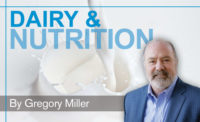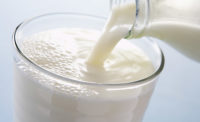The nutritional and health benefits of dairy food consumption have long provided industry with multiple opportunities to promote its products to health-minded consumers.
With an eye to the future consumer, the Innovation Center for U.S. Dairy recently conducted an in-depth study to assess emerging trends and identify growth opportunities that could impact dairy sales (access the “Future of Dairy Executive Summary” at USDairy.com).
As the U.S. population is aging overall and becoming less healthy, one of these opportunities is to market dairy’s role in healthy aging, leveraging the growing science indicating a link between dairy consumption and reduced risk for chronic diseases. In the future, that may include cardiovascular disease (CVD). A possible role for dairy in reducing risk of CVD may be surprising, given conventional wisdom about saturated fat. But science is beginning to suggest just that.
Dairy foods provide one-half of the calcium, nearly two-thirds of the vitamin D and significant amounts of several additional nutrients in the U.S. diet that are essential for health, while accounting for only10% of total calorie intake. However, dairy foods also contribute to saturated fat intake, a type of fat implicated in cardiovascular disease.
Research on CVD remains a priority of the scientific community because CVD affects more than 86 million Americans and costs more than $300 billion per year. While established risk factors include smoking, physical inactivity and excess body weight, the role of dietary saturated fats has become a matter of debate. Attributed in part to research conducted by the Dairy Research Institute, an organization founded by the national dairy checkoff program, the relationship between saturated fat from dairy foods and risk of CVD continues to be investigated. Emerging evidence indicates a neutral to potentially beneficial role of dairy foods for heart health.
The Dietary Guidelines for Americans recommend 3 cups per day of low-fat or fat-free milk and milk products for individuals 9 years of age or older, and less than 10% of total caloric intake from saturated fats. In light of the obesity epidemic, the Guidelines encourage Americans to consume foods in their lowest caloric form (for example, lower-fat versions). Despite these guidelines, Americans (older than 9 years) only consume about half of the recommended dairy servings each day (1.6 cup equivalents, on average).
Dairy intake and CVD risk
Research in the last five to six years has demonstrated that consumption of dairy is associated with a reduced risk for CVD. In fact, the research cited in the 2010 Dietary Guidelines Advisory Committee (DGAC) report indicated that not all sources of saturated fat may have the same effect on disease risk. The DGAC evidence-based review led the 2010 Dietary Guidelines for Americans to state that “Moderate evidence indicates that intake of milk and milk products are associated with a reduced risk of CVD and type 2 diabetes and with lower blood pressure in adults.”
The studies contributing to this conclusion examined consumption of total dairy products, indicating that the reduction in CVD risk was not specific to lower-fat dairy.
Since 2010, research in this area has grown, and consistently has indicated that the consumption of dairy may be associated with a reduced risk of CVD. However, a number of critical questions regarding dairy, including full-fat dairy, and CVD risk remain unanswered, some of which were posed by the 2010 DGAC. For example, since much of the research to date is from large population observational studies, there is a need for more randomized controlled clinical trials, and the DGAC encouraged that these trials include full-fat dairy. The Dairy Research Institute, as well as others involved in this research area, are pursuing these and other studies suggested by the DGAC to shed more light on this exciting area for dairy.
Looking ahead
Research continues to indicate that milk and milk products play an important role in the diet and may have a favorable effect on cardiovascular health. In addition, a growing body of research indicates that milkfat may not be associated with increased risk of CVD. However, additional studies will be required to confirm these associations. Until then, an important goal from a public health perspective is to help increase low-fat and fat-free dairy food consumption to meet the recommendations of the Dietary Guidelines.
Understanding the relationship between dairy and CVD risk is a research priority of the Dairy Research Institute. This will help the dairy industry tailor the product portfolio to the health and wellness needs of consumers. The Dairy Research Institute is an organization established under the leadership of America’s dairy farmers to work with and through industry and other partners to drive pre-competitive research in nutrition, products and sustainability. For additional information on dairy research, visit USDairy.com/DairyResearchInstitute.
Bryan G. Helwig, Erin E. Quann and Mickey Rubin of the Dairy Research Institute contributed to this article.



